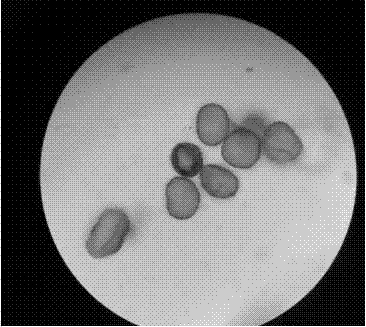Composition using microorganisms to ferment pollen typhae and application thereof
A technology of microbial fermentation and composition, which is applied in the field of medicine, can solve the problems of high heating temperature, destruction of active ingredients of Puhuang, and inability to make full use of active ingredients, so as to achieve high analgesic effect
- Summary
- Abstract
- Description
- Claims
- Application Information
AI Technical Summary
Problems solved by technology
Method used
Image
Examples
Embodiment 1
[0031] Embodiment 1: the preparation of the composition A of fermented Puhuang
[0032]Take 50g of Chinese herb Puhuang, add 1000ml of water to soak for 1.0 hour, add 50g of glucose, 10g of peptone, 1g of yeast extract, 1g of dipotassium hydrogen phosphate, 0.5g of magnesium sulfate 7 hydrate, 0.01g of ferrous sulfate 7 hydrate, adjust the pH value to 6.5 . Sterilize at 115°C for 50 minutes, and when the temperature drops to 30°C, inoculate the pre-cultured 5% by volume Monascus (CGMCC 3.567) bacterial solution, and place it on a rotary shaker at 30°C with a speed of 180 r / min Cultivate for 72 hours, then inoculate Bifidobacterium breve (CGMCC 1.2213) and Bifidobacterium adolescentis (CGMCC 1.2190) with a pre-culture volume percentage of 1.0%, culture at 37°C for 6 hours, and then inoculate with a pre-culture volume percentage of 1.0% % of Lactobacillus plantarum (CGMCC 1.19) and Lactobacillus casei (CGMCC1.3206), cultivated at 37°C for 24 hours, then lowered the temperature ...
Embodiment 2
[0033] Embodiment 2: the preparation of the composition B of fermented Puhuang
[0034] Take 200g of Chinese herb Puhuang, add 1000ml of water to soak for 2.0 hours, add 20g of glucose, 5g of peptone, 5g of yeast extract, 2g of dipotassium hydrogen phosphate, 0.2g of magnesium sulfate 7 hydrate, 0.02g of ferrous sulfate 7 hydrate, and adjust the pH value to 6.0 . Sterilize at 115°C for 50 minutes. When the temperature drops to 30°C, inoculate the pre-cultured 6% volume percentage Monascus (CGMCC 3.4701) bacteria solution, and place it on a rotary shaker at 30°C with a speed of 180 r / min Cultivate for 48 hours, then inoculate the pre-cultured 2.0% volume percentage of Bifidobacterium bifidum (CGMCC 1.5090) bacteria solution, cultivate at 37°C for 12 hours, and then inoculate the pre-cultured 2.0% volume percentage of Lactobacillus rhamnosus (CGMCC 1.104) cultured at 37°C for 24 hours, and then lowered the temperature to 28°C for 5 days. Sampling and detection showed that the p...
experiment example 1
[0035] Experimental example 1: Microscopic observation of fermented and unfermented cattail pollen grains
[0036] Get the fermented cattail cattail composition A, B prepared in Example 1, 2 and the non-microbial fermented cattail cattail composition prepared by a similar method, as test samples.
[0037] Take a small amount of the test sample according to the conventional smear method, stain with crystal violet solution and iodine test solution, decolorize with ethanol, and observe under an optical microscope at 400 times magnification.
[0038] Results: Unfermented Puhuang pollen grains have clear edges and complete pollen grains (see attached figure 1 ); the edges of fermented Puhuang pollen grains are blurred, the walls of the pollen grains have been broken, and the contents have leaked out in large quantities (see attached figure 2 , 3 ).
[0039] Conclusion: Microbial fermentation breaks the cell wall of pollen grains of Puhuang, which is beneficial to extract the co...
PUM
 Login to View More
Login to View More Abstract
Description
Claims
Application Information
 Login to View More
Login to View More - R&D
- Intellectual Property
- Life Sciences
- Materials
- Tech Scout
- Unparalleled Data Quality
- Higher Quality Content
- 60% Fewer Hallucinations
Browse by: Latest US Patents, China's latest patents, Technical Efficacy Thesaurus, Application Domain, Technology Topic, Popular Technical Reports.
© 2025 PatSnap. All rights reserved.Legal|Privacy policy|Modern Slavery Act Transparency Statement|Sitemap|About US| Contact US: help@patsnap.com



